With its unique design, impressive contaminant removal capabilities, and diverse range of options, it’s no surprise that reverse osmosis is one of the most popular at-home water treatment solutions in the US.
If you’re interested in purchasing one of these systems for yourself, you want to make sure that you get the best value for money – and, importantly, that you don’t over-pay.
The price of a reverse osmosis filtration system depends on a number of factors, including brand, size, filter lifespan, convenience, and so on.
In this guide, I’ll be discussing the price you can expect to pay for different types of RO water filtration systems on today’s market, and any other costs to be aware of.
Table of Contents
- 💰 Average Cost of a Reverse Osmosis System
- 🚰 Point of USE (POU) Reverse Osmosis System Cost
- 🏠 Point of Entry (POE) Whole House Reverse Osmosis Cost
- 🏢 Commercial Reverse Osmosis System Cost
- 📝 Factors Affecting Reverse Osmosis System Cost
- 🔧 Reverse Osmosis System Installation Cost
- 💡 RO System Maintainece & Operating Costs
- 🙋♀️ Frequently Asked Questions
💰 Average Cost of a Reverse Osmosis System
| System Type | Average Price Range |
|---|---|
| Countertop | $300 - $500 |
| Under Sink (tankless) | $300 - $600 |
| Under Sink (with tank) | $200 - $600 |
| Whole Home | $1,500 - $10,000 |
🚰 Point of USE (POU) Reverse Osmosis System Cost
Point-of-use RO water filtration systems are more affordable than whole house systems as they produce purified water at a specific source (usually for clean drinking water only). There are several types of point-of-use systems: countertop, under-sink with tank, and tankless RO water filters.
Countertop
The average cost of a countertop RO filter is $300-$500.
Again, these systems tend to be slightly pricier than tank-based RO systems as they don’t come with any installation costs (they can be set up in a matter of minutes). The fact that they don’t need connecting up to a waterline is also very convenient, especially if you’re looking for a more portable option.
We Recommend: AquaTru Countertop RO System
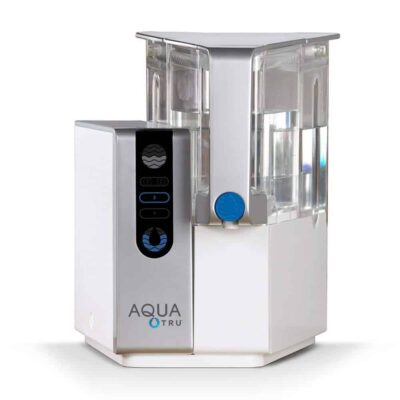
- Quick ‘plug n play’ setup takes only 3 minutes
- No invasive installation, perfect for renters
- Tested to NSF standards 53, 58, 42, 401, P473
- Much more efficient with a ratio of 4:1 (produced to wastewater)
- Clean water dispensing tank is removable
- Compact, space-saving design
- 👉 Read my full review
Our readers get 15% off at waterandwellness.com – 👉 Click here for code
Under Sink (tankless)
Tankless RO systems tend to cost a little more money; typically around the $300 – $600 price range.
You pay for the convenience of getting instant access to clean drinking water from a system that can filter water instantly, as opposed to tank-based systems, which take several hours to fill the storage tank with purified water.
We Recommend: Waterdrop G3P800
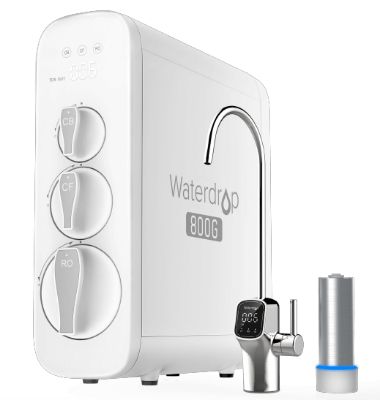
- Produces up to 800 gallons per day
- NSF 58 & 372 certified
- Built in booster pump
- Amazing efficiency ratio of 3:1
- 3 filters combine to create 7 stages of filtration
- Super easy filter changes
- Space-saving design
We love the G3’s value & performance – get $199 off & experience it yourself!👉 Click here for code
Under Sink (with tank)
Under-sink reverse osmosis water filters with a storage tank are the traditional type of point-of-use RO filter. An under-sink system costs between $200 and $600 when it comes with a tank. You can find plenty of high-quality systems at the lower end of this price range.
We Recommend: Aquasana OptimH2O
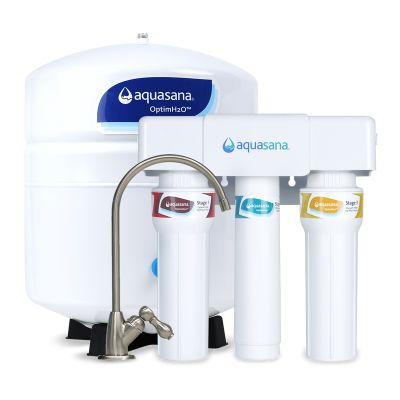
- Produces 35 gallons per day
- NSF certified for removal of 88 contaminants
- Certified NSF/ANSI Standards 42, 53, 58, and 401
- Remineralization filter included
- Includes it’s own dedicated faucet
- Easy twist-on filter replacement
🏠 Point of Entry (POE) Whole House Reverse Osmosis Cost
A whole-house RO unit will usually cost upwards of $1,500, just to start. The average price ranges between $1,500 and $10,000, depending on the size and capacity of the system, and whether you purchase the system with any extras.
Whole-house RO systems are generally the most costly systems because they offer whole-home benefits, eliminating your need for bottled water, softening your home’s water supply, and removing chlorine.
We Recommend: US Water Systems Defender Whole House RO System
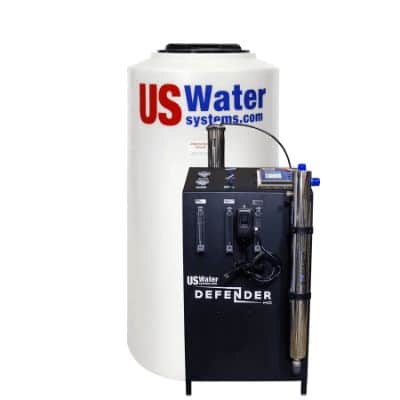
- Massive 5:1 efficiency ratio
- Up to 8,000 GPD produced water
- Up to 250 gallon holding tank
- Can be combined with various pre-treatment systems
- Permeate flush increases membrane lifespan
- Optional remineralization and pH neutralization filters
🏢 Commercial Reverse Osmosis System Cost
How much does a reverse osmosis system cost if it’s intended for commercial use? This varies based on just how big your system is, and what you need it for. Most commercial units are whole-house, and can cost between $1,000 and $10,000 – it really is that broad.
As for huge-scale industrial applications, it’s pretty impossible to give a set price range, as it’s affected by the requirements of the business.
📝 Factors Affecting Reverse Osmosis System Cost
System Type
The type of reverse osmosis system determines its size, and the bigger the size, the more costly it’ll be. For instance, a whole-house reverse osmosis system will cost significantly more than a smaller under-sink model or a countertop unit.
Typically, under-sink reverse osmosis systems with a tank are the most affordable, costing around $200-$600, depending on the brand. Moving up to a more modern tankless system may contribute an additional $50-$100 to the price.
Countertop RO systems come at a similar cost – generally $300-$500, brand depending. A whole house reverse osmosis system will generally be the most costly, costing thousands, rather than hundreds. That’s because these systems are larger, but also because they’re rarer – manufacturers have less competition, so can afford to price higher.
System Efficiency
The efficiency of a reverse osmosis system is a measurement of two things: how quickly the system can produce filtered water, and how much water has been lost in the process.
All reverse osmosis systems waste water during the water treatment process. Unfortunately, there’s no getting around it – but many systems today are far more efficient, wasting less water than the original RO system, and this makes them less costly in the long term.
Traditionally, RO has a pure water to wastewater ratio of 1:4, meaning 1 gallon of pure water is produced for every 4 gallons of water wasted.
These systems are the cheapest because you’ll waste the most money on them in the long run. Nowadays, you can find RO systems with much-improved ratios of 1:2 and even 1:1, and these typically cost around $100-$200 more for the long-term savings you can enjoy.
Filtration Stages
Reverse osmosis systems cost more if they boast an above-average number of filtration stages.
In a typical reverse osmosis system, water flows through 4 stages: a pre-sediment filter, a carbon filter, a semi-permeable membrane and a post-filter.
This type of system is capable of removing more than 99.9% of TDS (total dissolved solids) from water. However, some under-sink and whole house reverse osmosis systems feature more than double this amount – sometimes even up to 10 or 12 stages.
Having extra filtration stages means that the water that’s produced will be about as clean and pure as it gets. Extra-stage filters may be additional carbon block or GAC filters and alkaline or mineral filters, which introduce healthy minerals back into your filtered water.
The more filters a system has, the more money you’ll need to spend on replacements, too. Be careful, though – it certainly sounds impressive for a reverse osmosis water filtration system to have, say, 10 filter stages, but it probably won’t do much more to your water, so it’s worth considering whether it’s actually worth the extra cost.
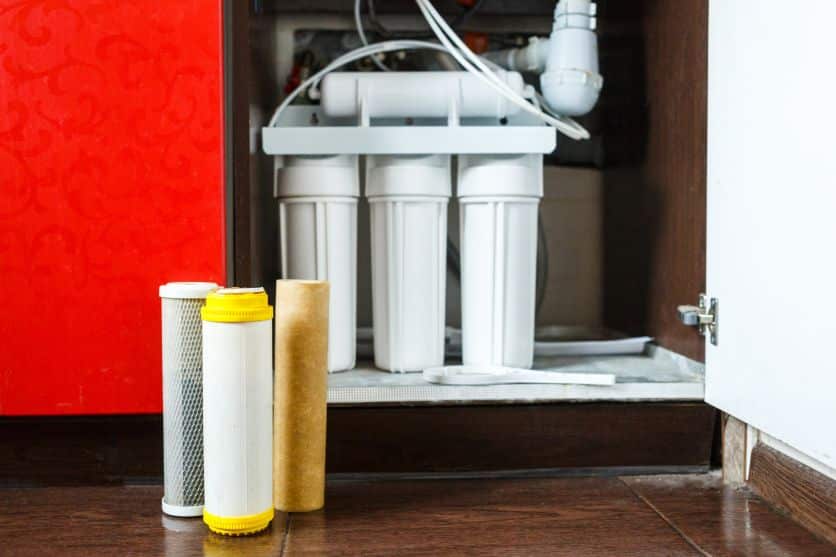
Brand
There are certain sellers that have been leaders in the water filtration industry for decades. They’ve proven to their customers that they’re dependable and reliable in the long run, which is a big bonus considering most RO systems have a lifespan of more than 10 years. These brands can price their products at a premium because they already have a solid fanbase.
On the other hand, new and emerging sellers might be just as legitimate, but they need time to prove it first. If you purchased a product that was only manufactured 1 year ago, you won’t be able to look online to see whether customers who have owned the system for 10 years are still impressed. That’s not to say that the product isn’t capable of lasting for this amount of time, but to win your trust, newer sellers will keep their prices lower than the industry leaders.
If you’re prepared to take a gamble on a newer product, you could save yourself a few hundred dollars – just make sure the manufacturer has all the right certifications and the system you choose has a good warranty. That way, you’re less likely to make a decision you might find yourself regretting later down the line.
Certifications
On the subject of certifications, certified reverse osmosis systems cost more money because customers know immediately that they’re reliable. The most sought-after certification for reverse osmosis units is NSF/ANSI 58, which is the national standard for RO systems and indicates that a system has been tested and deemed effective in terms of efficiency, structural integrity, contaminants removed, and materials used.
If a reverse osmosis system doesn’t have an NSF certification, the first question a knowledgeable customer will ask is “why?”.
Any manufacturer can apply for an NSF certification, so to not have a certification suggests that a manufacturer is making claims about a product that might not be true. Of course, that’s not always the case, but it’s for this reason that manufacturers of NSF-certified RO filters can get away with lifting their prices.
Something to be aware of is that many brands may use lingo like “tested to NSF certification 53”, which doesn’t actually mean that their product is certified. If an RO system is certified, the manufacturer will link to a document produced by NSF that proves this. Check customer reviews or ask the manufacturer if you’re unsure.
Add-ons
Many under-sink or whole home reverse osmosis systems can be purchased with a number of optional add-ons, including UV lamps, booster pumps, and remineralization filters. You may even want to purchase a water softener to install before your reverse osmosis system if your tap water is particularly high in hardness minerals.
None of these extras are requirements if you’re just looking for a filtered water solution, but many of them have their appeal. For instance, if you want to drink clean water but you’d rather it still contained healthy minerals, you may be interested in what a remineralization filter can offer.
Additionally, if your water contains pathogens, a UV lamp can offer more protection, and if your water pressure is lower than average, a booster pump can help your RO system to work more effectively.
The price of an add-on is dependent on what you’re looking at.
Most manufacturers will offer a discount on purchasing your RO system with another one of their water treatment products, so it’s worth making a joint upfront purchase if you think you’ll probably buy an additional component in the future anyway.
You can expect to pay approximately $100-$600 for a UV purification lamp and $50-$100 for a remineralization filter. A water softener can be a hefty additional investment, costing upwards of $1,000.
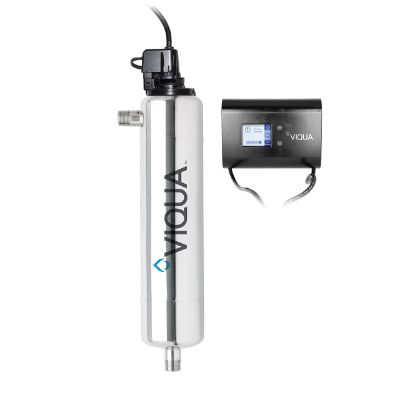
🔧 Reverse Osmosis System Installation Cost
Whether you’re installing a whole-house reverse osmosis system, an under-sink unit or a countertop application, there’s a high chance that you’ll need to spend more money on the installation itself.
Your exact installation costs depend on what you need to pay for.
Most systems that connect up to your water line – i.e. an under-sink or whole-house reverse osmosis system – will come with all the right components, but may be missing connections and fittings that are needed for installation. A trip to your local hardware store may set you back $20 at the most, so this isn’t a big additional cost to consider.
A bigger cost that may be unavoidable, depending on your situation, is the price of hiring an expert to install your RO unit for you. This is particularly something to consider if you’re installing a whole house reverse osmosis system, as getting something wrong could end up cutting off your water supply.
I would recommend that you look into the installation process of the RO system you’re interested in first.
Check out some video guides and the user manual (if you’ve purchased the system already). If you’re confident in your DIY abilities, give it a go. But if you think that paying to rectify your mistakes will cost more than just paying for a plumber in the first place, you know what to do.
The only system you might get away with spending nothing on is a countertop RO filter, as this system typically requires minimal setup and usually comes with all the parts included for the job.
💡 RO System Maintainece & Operating Costs
Aside from the upfront price of a reverse osmosis unit, you should also consider the ongoing costs of running the system. I’ve highlighted some of the most common maintenance and operating costs below:
Membrane & Filter Replacement
No water filter lasts forever, and the same goes with a reverse osmosis system.
The carbon filter, sediment filter, post-filter and reverse osmosis membrane will all require replacing according to guidance in your user manual to ensure the system can continue to operate at a high standard.
If you don’t replace your filters, they’ll eventually become so clogged with sediment that you’ll experience problems with your water pressure. Additionally, the filters may get so worn that they can’t trap contaminants in their media, which means your system won’t even produce your intended results.
Typically, you’ll need to pay for new water filter cartridges every 6 months to 1 year, and a new reverse osmosis membrane every 2 years. A pack of 3 filters will usually cost around $50-$70, depending on the brand, and a single RO membrane will cost between $30 and $70.
Pro tip: Look out for deals and discounts from your manufacturer, as well as online promo codes that can help you save money by simply purchasing your filters directly through the manufacturer.
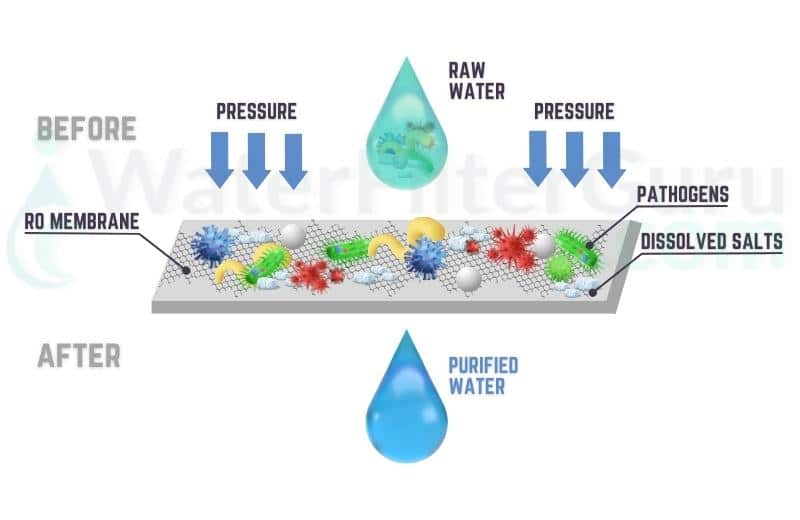
Wastewater
As I mentioned earlier in this guide, there’s no avoiding water waste when using a reverse osmosis water filter.
Luckily, you’d only notice a significant difference in your water bill if you were using a high-volume application – which is unlikely if you’re just providing clean water for your family.
Whole-home reverse osmosis systems will waste the most water as they’ll be used the most frequently.
However, you probably won’t even notice the cost of this wastewater. If you’d still rather not waste so many gallons of water, consider buying a recycle valve, which can bring your recovery rates right up to around 75%.
Electricity
Under-sink and whole-home reverse osmosis systems don’t use electricity to operate, as they use water pressure to send water quickly through their filtration stages.
However, countertop water filters don’t have the advantage of water pressure, and require electricity to do the same job. With that said, most systems have a lower wattage than a light bulb, so occasional use won’t flag up anything huge on your electricity bill.
You’ll also need electricity if you purchase a pressure pump, a water softener or a UV light alongside an RO system, so be sure to add this to your system cost if you plan to purchase these extras.
🙋♀️ Frequently Asked Questions
Is the RO system cost worth it?
That’s dependent on the quality of the product you buy. But assuming you’ve purchased a top-of-the-range system, then yes, the investment is worthwhile.
This is especially the case if you only drink bottled water, as you’ll be able to save hundreds of dollars per year by switching to an effective at-home water treatment solution. You’ll quickly make back the money you spent on your upfront purchase with your year-by-year savings.
Remember, also, that most reverse osmosis systems have a lifespan of at least 10 years. As long as you look after your system, performing the recommended maintenance and cleaning/ replacing worn-out parts as necessary, your initial investment will be totally worth it. Let’s say you spent $600 plus $50 per year on changing your filters. That’s $900 split over the course of 10 years, which really isn’t so bad.
Of course, repairing a reverse osmosis system will cost you significantly more money, with some major repairs costing up to $500. My advice is to give your unit a thorough check-over every 6 months or so, which will help you to spot any problems before they become expensive.
Where can I buy an RO system?
Your local hardware store will probably have a good selection of these water filtration products, but I would recommend looking online for more choices and bigger savings. Shopping online also gives you the advantage of being able to read other people’s reviews to see how a product really performs. If a system is particularly expensive to run, or customers generally agree that it isn’t worth the price, you can simply look elsewhere for a better deal.
The majority of manufacturers offer free shipping throughout the country, too, which is a great perk to take advantage of.
What is the cost of a reverse osmosis system per gallon?
It’s hard to give an exact figure for this, as it depends on how efficiently your RO system can filter water and where in your home it’s installed. However, the average cost per 1,000 gallons is $3.50. Considering the average person drinks half a gallon of water per day, this certainly isn’t a cost that’ll keep you up worrying at night.
What type of RO system is for me?
Budget aside, that’s a question that’s too big to answer here! To keep it short and sweet, if you’re only looking to enjoy clean tap water, you probably don’t need to splash out on a whole-home RO system. But if you use well water, and your water source is bad enough to require whole-home RO filtration, it may be something you need to consider. Check out my ultimate reverse osmosis guide if you want to know more about your options.
